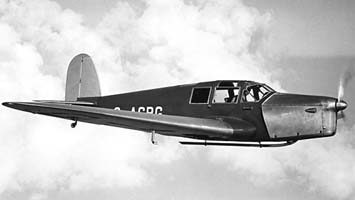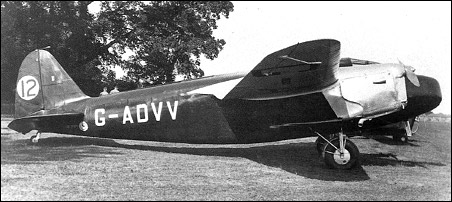British Aircraft Eagle
The British Aircraft Eagle was a British light aircraft that was designed and built in the 1930s. The aircraft caught by participating in several intercontinental air race quite a stir.
History
The Eagle was the first self-construction of the clamping British Aeroplane Company. The at London Air Park -based company was founded for the purpose of planting of sport aircraft Klemm Light Aircraft GmbH at the beginning of the 1930s, Major EF Stephen. As of November 1933 there was the British clamp Swallow, a licensed replica of the Klemm Kl 25, built.
The Eagle was similar to the Klemm Kl 32, but was developed independently by G. Handasyde, the chief developer of the British clamp Aeroplane Company. With the larger, more powerful, and through the closed cabin also more comfortable model, a successor for the Swallow should be established on the market. The machine made its maiden flight in early 1934. Variant of the original six were built. In 1935 the improved Eagle II appeared in the same year the company changed its name to British Aircraft Manufacturing in order to emphasize the independence of the constructions. The Eagle II differed from its predecessor by changing rudder and a long tail. From this version originated a total of 37 copies.
Construction
The Eagle was designed as a low-wing monoplane. Fuselage and wings of the aircraft consisted of a wooden structure that was covered with plywood and covered with fabric. Only the engine cowling was made of metal. The wings could be folded for space-saving parking. A characteristic feature of the machine was the retractable landing gear, a copy of the Eagle II series, however, was built with a solid spur wheel chassis. Crew and passengers were in an enclosed cabin space, the access was made possible by two doors are opened to the front. The pilot took on a single seat at the front court, the two passengers sat side by side behind him. When engine was a de Havilland Gipsy Major, a four-cylinder inline engine with hanging cylinders and an output of 130 hp.
Use
The Eagle was mostly sold to private owners and was there primarily as a sports and touring aircraft to use. Some specimens were procured from various flying clubs.
Getting fame of the type by its participation in the MacRobertson Air Race 1934. Flight Lieutenant G. Shaw went with the start number 47 with his name on the The Spirit of Wm Shaw & Co Ltd baptized Eagle II at the start, the race but had to Bushir give up. An Eagle II also took the Schlesinger Race between England and South Africa in part, but this aircraft did not reach the target. The crew Alington and Booth had to abandon the race first. On landing near Regensburg retractable their Eagle has been damaged. Between 1935 and 1937 launched several pilots with aircraft of this type when discharged annually King's Cup Race.
At the outbreak of the Second World War, the Royal Air Force pulled a seven Eagle and used them as a coach. Two other aircraft are to have come in the same role in Australia used another machine in Kenya. In this case, the retractable landing gear proved to be a weak point of the machine, most aircraft had to be written off due to suspension damage. Only two aircraft survived and were used after the war by civilian operators in Australia.
Currently, two aircraft of this type have been preserved. The G- AFax is displayed at the aviation museum Fundación Infante de Orleans in Spain and was maintained at least until 2009 in an airworthy condition, the VH - UTI is located in an exhibition in Australia.
Variants
From the first time in 1934 Eagle flown a total of six were built. From from 1935 made Eagle II created 37 copies, one with fixed landing gear. The first, made before the renaming of the company were called Eagle British Eagle terminal.










